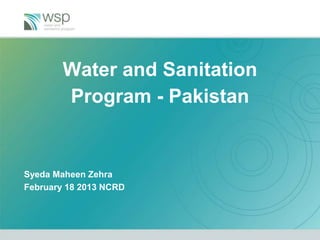Water and Sanitation Program
- 1. Water and Sanitation Program - Pakistan Syeda Maheen Zehra February 18 2013 NCRD
- 2. Pakistan at a glance Populatio 173 million n ï§ Complex and contested governance -18th Poverty line 36% < $ 1.25 constitutional amendment Access to 92% ï§ Emergence of new institutional structures Water Urban 95% ï§ Catastrophes â Floods damage of US$ 9 billion Rural 91% ï§ Security crisis â FATA Access to Sanitatio 78% ï§ Government spends < 0.2% of GDP on WSS n Urban 98% Rural 67% 2
- 3. Water Urban sprawl is reducing % household connections despite investments % household connections are steadily increasing but are deplorably low âĒ Pakistan is on its way to meet MDGs âĒ Quantity is not the problem â QUALITY is! âĒ <25% receive safe water and 200,000 children die each year due to water related diseases 3
- 4. 90 80 70 Sanitation 60 50 40 Over All 30 Latrine 20 10 Coverage 0 Baluchis Pakista PSLM 2006- Sindh NWFP Punjab tan n 07 Flush 25 55 52 64 58 Non-Flush 52 30 17 5 15 No Toilets 23 15 31 31 27 Acces to Toilets 73 85 69 69 73 Total economic $ 5.8 billion 6000 cost of poor sanitation for 4000 the year 2006 was estimated 2000 $ 262 million as 395.34 $ 374 million billion PKR 0 $ 88 million (6.449 billion USD) which is Health costs Water costs equivalent to Other 4.53% of GDP welfare Tourism in Pakistan 4
- 5. WSP Overview ï WSP is an international partnership administered by the World Bank with 30 years of experience ï WSP provides technical assistance, policy advice, and capacity building in over 24 countries to improve access to water and sanitation services for the poor. ï Operates globally with regional offices in Africa, East Asia and the Pacific, Latin America and the Caribbean, and South Asia. 5
- 6. The 6 Global Business Areas 1. Scaling up rural sanitation and hygiene 2. Creating Sustainable Services through DPSP 3. Supporting poor-inclusive WSS sector reform 4. Targeting the urban poor and improving services in small towns 5. Mitigating and adapting WSS delivery to climate change impacts 6. Delivering WSS services in fragile states2 WSP may not only be seen as a water and sanitation organization but we are very much into governance and accountability 6
- 7. WSP in Pakistan ïķ WSP is a sector-level policy advisory unit: âĒ As a think-tank, we provide evidence based advice on sector reforms âĒ As a partnership platform, we seek to create links between organizations âĒ Demand responsive & strategic engagement ïķ We bring a holistic view of WSS sector: âFix the institutions that fix the pipesâ 7
- 8. WSP and Rural Water and Sanitation ïķ Undertaking initiatives that are primarily focused on women e.g. community led total sanitation (CLTS) ïķ Providing training to government agencies and service providers ïķ Providing training to and facilitating peer learning amongst community groups ïķ Piloting innovative approaches for social mobilization with a focus on womenâs special needs e.g. barefoot consultants 8
- 9. Story of Lakshmi ïķCommunity Activist in Sumaro ïķTrained for triggering Open Defecation Free Behavior ïķEarning 5000 rupees a month as a barefoot consultant for TRDP 9
- 10. End noteâĶ. WSP holds CLTS conclave where community actors who have contributed to make their villages open defecation free were rewarded â not surprisingly women claimed a high share of rewards 10
- 11. 750,000 people in over 670 villages in Pakistan are no longer exposed to the indiscriminate disposal of human excreta.
Editor's Notes
- Complex and contested governance particularly in the context of constitutional measures -18th constitutional amendment and devolution to provincesEmergence of new institutional structures at the federal level to tackle the issues related to policy jurisdiction of the federation â capacity gap at both, federal and provincial levelsWith an estimated damage of over US$ 9 billion, the devastating floods in mid-2010 further added to the economic and political woes. Development context in the aftermath of floods have considerably changed in terms of priorities of external partnersThe conflict in Khyber Pakhtunkhwa (KP) and the Federally Administered Tribal Areas (FATA) led to one of the worst security crises in Pakistanâs history, displacing millions of people and disrupting public services. Post-crisis support for KP and FATA has become a significant development priority for government and donorsEstablishment of Capital Administration and Development Division - To start with as many as 20 federal government departments previously existing under ministries of environment, health, education, culture, livestock, population, special education, youth affairs and tourism have been placed under the CADDGovernment funding is insufficient and hence reliance on donor for WSS is obviousThe story line converges to âĶâĶ The resulting uncertainty has also created a situation lacking clarity in institutional mandates, structures, roles and capacities to provide improved WSS services. WSP-SA is ideally placed to support its clients within the devolving municipal sector and to the new public structures lacking knowledge and capacities











